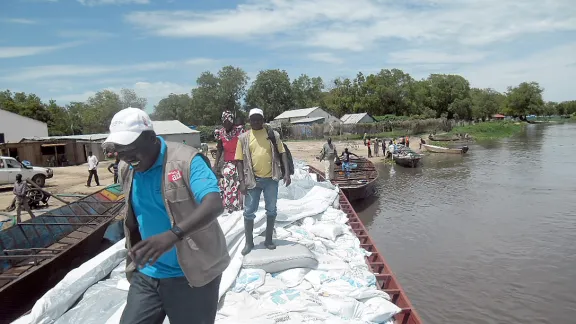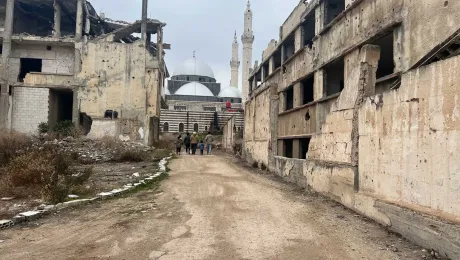
NFIs from the LWF and partner organizations are ferried by boat to remote islands in Twic East County, South Sudan. Photo: LWF South Sudan/George Taban
Poor Response to Funding Appeals for Refugees in Ethiopia, Kenya and Uganda
(LWI) - Since the December 2013 outbreak of violence in South Sudan, food insecurity has deteriorated at an alarming rate in the three conflict-affected states of Jonglei, Unity, and Upper Nile, leaving farmers unable to sow or harvest their crops and herders prevented from migrating between grazing areas.
Despite recent ceasefire agreements between the government and rebel group, humanitarian access remains difficult for communities supported by The Lutheran World Federation (LWF) in Maban, (Upper Nile State), Ajuong Thok, (Unity State) and Bor and Twic East (Jonglei State) counties.
An estimated 3.9 million people in South Sudan are experiencing emergency levels of food insecurity, according to the World Food Program (WFP), with a high risk of famine for some parts of the country in the coming months if urgent supplies do not get through. The United Nations Office for the Coordination of Humanitarian Affairs estimates that 1.5 million people have been displaced in the conflict affected states since the violence erupted, placing previously food secure communities under increasing strain.
Intervention is compounded for people living in remote areas such as Dhiam-Dhiam village, one of 20 islands along the banks of the White Nile, says George Taban, education officer for the LWF Department for World Service (DWS) program in South Sudan. They not only lack basic sanitation and educational services but also have limited access to health facilities. “The nearest healthcare unit in Patiou is 12 km away from Dhiam-Dhiam, a whole day’s journey through the river, which is the only means of transport,” Taban adds.
In the three states, gains made by the LWF and its partners over the past years in helping rural communities build sustainable livelihoods, promote peace, human rights and reconciliation and strengthen capacity to respond to disasters and access education, have largely been obliterated by the ongoing violence.
The LWF is seeking funds to continue scaling-up not only its humanitarian emergency support to internally displaced South Sudanese and bridge the food gap but to also support the 400,000 who are refugees in neighboring Ethiopia, Kenya and Uganda.
Ethiopia: Insufficient Shelter and Basic Services for 100,000
Poor response to funding for ACT Alliance appeals for South Sudan issued earlier this year continue to hamper efforts to provide adequate essential services to the refugees supported by DWS programs.
At the sites in western Ethiopia’s Gambella refugee camp, the LWF program provides water, sanitation and hygiene (WASH) services, and psychosocial support to nearly 100,000 South Sudanese. However, additional funding is required for basic non-food items (NFI) and livelihood support to the refugees, over 90 percent of who are women and children below the age of 17 years.
The Leitchour site, originally planned for 20,000 people has been expanded to shelter around 47,000 persons to cope with the influx. Still, insufficient funds to the ACT appeal and other sources, uncertainty on camp stability due to flooding, and anticipated new refugee influx from Somalia due to famine there are major challenges cited by Sophie Gebreyes, LWF representative for the DWS Ethiopia program.
Influx to Kakuma Puts Pressure on Old Infrastructure
In northern Kenya, Kakuma refugee camp, originally designed for 100,000 inhabitants has been expanded to a capacity for 120,000 but now hosts 168,000 refugees, out of whom nearly 40,000 are South Sudanese. LWF focus there includes education, child protection, provision of water and community services.
While 65 percent of the South Sudanese refugees at Kakuma comprise children, this number includes about 20 percent unaccompanied minors (UAM), a majority of who are boys. The camp’s reception and protection centers are congested, shelters are insufficient and there are no alternative care systems for vulnerable groups such as UAMs. Access to water has been significantly reduced as water levels in all boreholes are dropping and some of the holes are collapsing. In addition, the supporting infrastructure is old and poorly maintained; therefore leakages in the pipe network among other factors make it impossible to include water distribution in any camp extension.
Wanting Education Facilities
The education services at Kakuma face similar challenges as schools are dilapidated and there is no available space to put up new buildings. The existing classrooms are insufficient and there are not enough teachers, school materials and meals for students. “The ACT Appeal has been very slow in attracting resources,” says Lennart Hernander, the LWF representative for the Kenya/Djibouti program. The recent Kenyan government security operation to send all urban refugees to designated camps is also increasing the numbers at Kakuma, he adds.
In northern Uganda, the LWF is providing NFIs, psychosocial and livelihood support, child protection, WASH and community services, and peace building activities to over 87,000 refugees from South Sudan currently located in all the new settlements in Adjumani district. Women and children account for 87 percent of the refugee population there, with the latter representing more than 64 percent of the nearly 137,000 South Sudanese who have sought refuge in the country. “That 79 percent of all primary-age children are not attending school,” is one of the main challenges, adds Jesse Kamstra, LWF representative for the DWS Uganda program.


